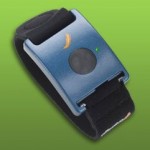New technology for diagnosing Sensory Processing Disorder?
 Marketers and scientists love to measure arousal.
Marketers and scientists love to measure arousal.
Arousal – whether Lizzy is alerted or sleeping through a specific environmental cue is a key component of Sensory Processing Disorder.
In the olden days researchers corralled subjects into laboratories and attached electrodes to their bodies. They introduced potentially interesting objects or situations and then watched as pens drew colored spikes onto mile-long rolls of graph paper.
Measuring arousal is big business. Over the years equipment has become sleek and specialized. No longer confined to a laboratory, the research subject wears a wireless biosensor attached to an elastic wristband, and carries on unencumbered in whatever endeavor inquiring minds wish to measure. At the end of the experiment the biosensor plugs into a USB wire and a gazillion bytes of data organize instantly into charts and graphs on a computer.
see Science Friday: How do you really feel? Your computer may know
Some of this research is geared toward sensitivity. Specifically researchers are studying autism – which is also big business. The Autism and Communication Technology (ACT) department at the MIT Media Lab is working to “foster the development of innovative technologies than can enhance and accelerate the pace of autism research and therapy.”
Autism and Communication Technology at the MIT Media Lab
Innovative technologies? Yes, the biosensor on a bracelet I just mentioned? It’s called a Q Sensor.
It measures, among other things, skin conductance which “goes up with excitement and with things that impact attention.”
On the face of it, this research appears to be about understanding and treating the communication/social/language problems related to Autism.
But when I looked into their list of the projects, I see that some of ACT’s work involves capturing “sympathetic nervous system arousal, temperature, physical activity and other physiological indications [related to] sleep, arousal, discomfort or distress.”
If I was wearing a Q Sensor right now, thinking about the possibilities of this type of technology used for diagnosing and treating SPD, there would be mountain peaks on the graph that marks heightened arousal.
With objective, measurable information professionals would have the potential to:
- quickly, decisively and accurately diagnose children (and adults)
- discover exactly which senses over or under respond to exactly which stimuli
- measure which treatments bring the quickest and most reliable relief
- dispel the myth once and for all that hyper- or hypo- sensitivity is merely a symptom of emotional or moral shortcoming, best treated with stronger discipline.
As far as I have read, besides a physical exam to determine muscle weakness, the diagnosis and treatment of SPD is about outwardly observable or self-described reactions to stimuli. It is checked boxes on standardized forms.
We don’t always reliably remember, or accurately know, what our physiological responses to events are. Rosalind Picard, the driving force behind getting the Q Sensor to market, wore it one day on a trip to a Six Flags theme park. She was surprised to discover the biggest peak in her electrodermal activity was not on the roller coasters but in the morning trying to get the kids out the door.
How would the life of a Sensational be different if we could actually see objective data showing over- or under- responsivity in our daily activities? We wouldn’t have to “be on the look out” for what set us off. Part of being over-stimulated is losing the ability to concentrate. How can we accurately determine anything when we are the exact opposite of an impartial observer?
I, personally, cannot tell the difference between under-stimulated lethargy and the exhaustion that comes after a numbing encounter with a toxic environment. It would be nice to know, do I need to feed my senses by dancing a jitterbug or lie down for an hour or two in a dark, quiet room?
What do you think about utilizing technology like this to enhance the diagnosis and treatment of SPD? What might be the downsides?
I welcome your comments. To comment, you must give your email address (which will remain strictly confidential) but you don’t have to join anything or memorize a password.
cool blog!
Did you know, scientists have actually identified SPD using EEGs?
http://www.spdfoundation.net/pdf/davies_gavin.pdf
Thanks Marci,
I did not know that! I will definately investigate and, of course, write all about it :)
I am all for this wow what it could help adults and kids ! Also maybe ins co would start paying for the ot and things children diagnosed early need ! Since it could actually be proven and no a made up diagnosis as my insurance company state to me :(
We’ll keep speaking up. As awareness grows, insurance companies will have no place to hide :)
We just published a case study on this topic: The Sensory Processing Disorder Foundation uses the Q Sensor device to measure the effectiveness of a new occupational therapy treatment: bit.ly/Zd7QJ2